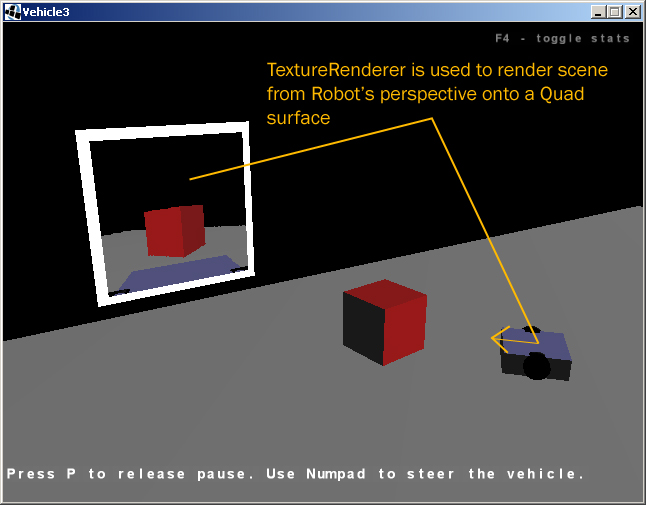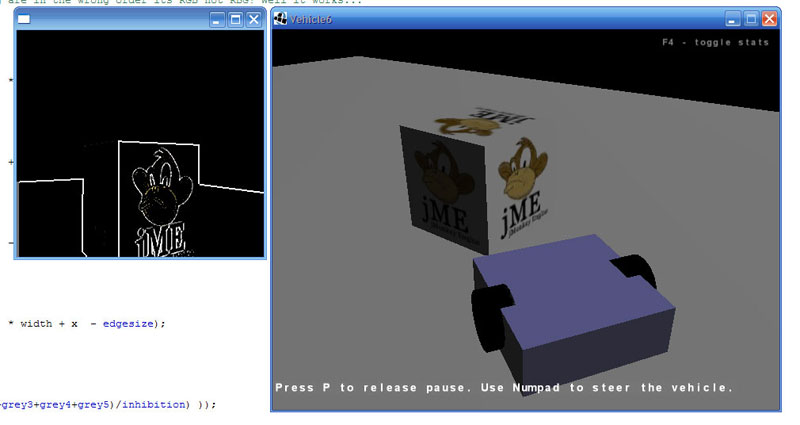Finally got it working :D Now offscreen-rendering the Robot's perspective, applying post-processing (in this case lateral-inhibition/edge detection) and displaying the result on a separate SWT Shell.
If anyone else needs help with this, I think I can help now. Thanks again to everyone who helped me.
This is what I did in simpleInitGame() to create the OffscreenRenderer:
/*Create the OffscreenRenderer*/
osRenderer = ((LWJGLDisplaySystem) display).createOffscreenRenderer(320, 320);
osRenderer.setBackgroundColor(new ColorRGBA(0f, 0f, 0f, 1f));
if ( osRenderer.isSupported() ) {
osRenderer.getCamera().setFrustumPerspective(45f, 4f/3f, 1, 200);
osRenderer.getCamera().setLocation(new Vector3f(0, 0, 75f));
} else {
//LOGGER.debug( "Offscreen rendering is not supported!");
}
/*I attached it to a Node so I can make that node follow the Vehicle*/
camNodeOS = new CameraNode("Camera Node Offscreen", osRenderer.getCamera());
camNodeOS.setLocalTranslation(new Vector3f(0, 50, -50));
camNodeOS.updateGeometricState(0, true);
camNodeOS.setLocalTranslation(-1, 2, 0);
Quaternion q2 = new Quaternion().fromAngleNormalAxis(90 * FastMath.DEG_TO_RAD, new Vector3f(0, 1, 0));
camNodeOS.setLocalRotation(q2);
// Attach the CameraNode to the Vehicle
vehicle.attachChild(camNodeOS); // Remember "vehicle" is attached to the rootNode
Here is the code in SimpleInitGame() to create second shell to display the result from processing the Offscreen image. The "image" is a org.eclipse.swt.graphics.Image that is accessible to simpleRender() and simpleInitGame().
display2 = new Display ();
shell = new Shell(display2, SWT.SHELL_TRIM | SWT.DOUBLE_BUFFERED);
shell.setSize(320, 320);
shell.addPaintListener(new PaintListener(){
public void paintControl(PaintEvent e){
if(image != null){
e.gc.drawImage(image, 0, 0);
}
}
});
shell.open ();
in simpleRender() I tell the Offscreen renderer to Render and retrieve the ImageData from the OffscreenRenderer:
osRenderer.render(rootNode);
IntBuffer buffer = osRenderer.getImageData();
// Create a new ImageData Object for the retrieved (and possibly modified) pixels
imgData = new ImageData(width, height, 32, new PaletteData(0xFF0000, 0x00FF00, 0x0000FF));
/* Later I access the pixels via */
for (int y = 0; y < height; y++) {
for (int x = 0; x < width; x++) {
int p = buffer.get((height - y - 1) * width + x);
/* Do Postprocessing on Pixels Here */
// Write the pixels to the new imData Object
imgData.setPixel(x, y, p);
}
}
// Then Update the Secondary Shell using the new "imgData"
//Clear the Image Data Resources
if(image != null){
image.dispose();
}
//Create the new Image Data
image = new org.eclipse.swt.graphics.Image(display2, imgData);
//Redraw the Shell we created in simpleInitGame
if(shell.isDisposed() == false){
shell.redraw();
}

